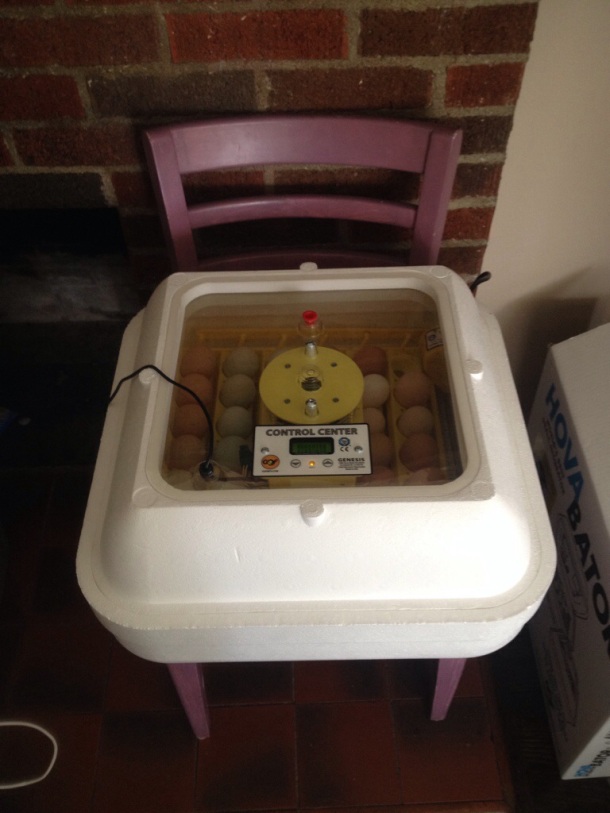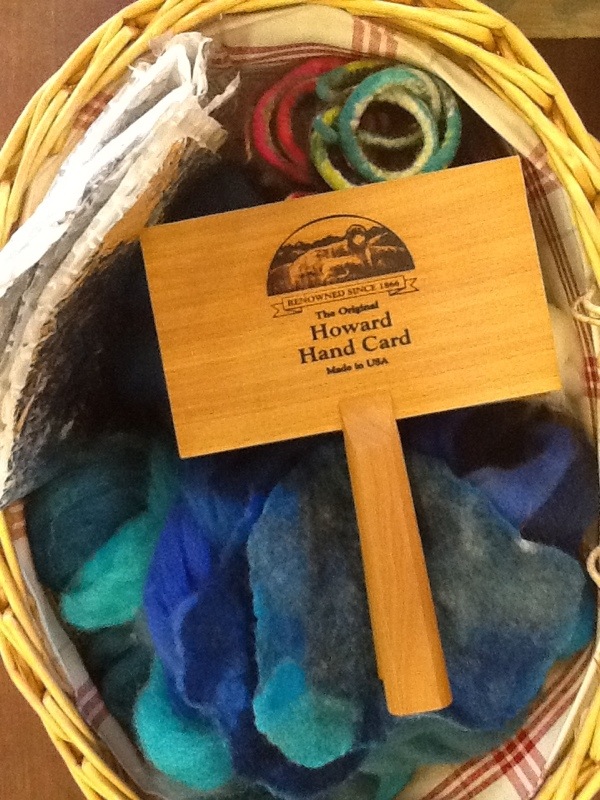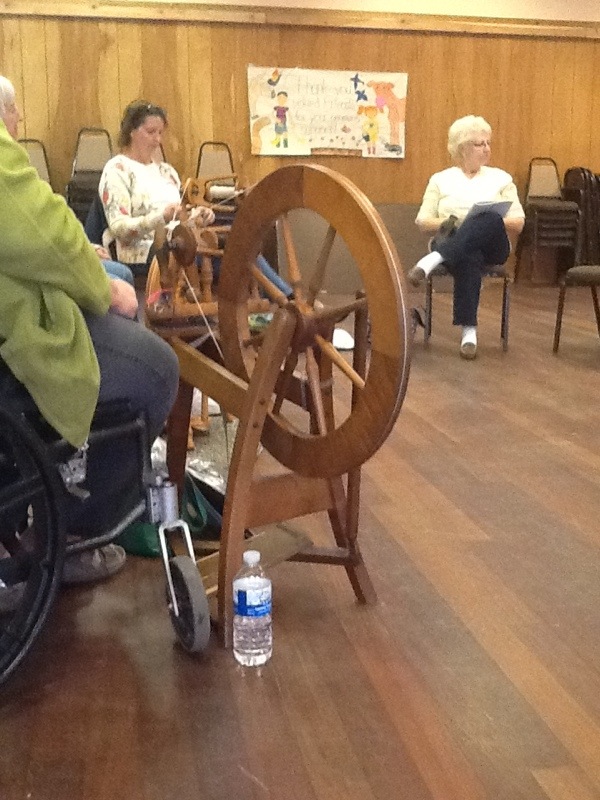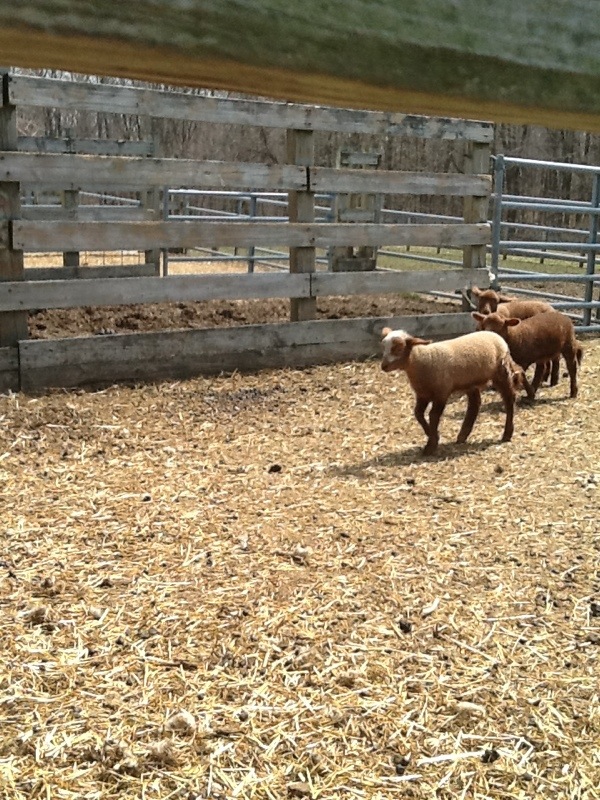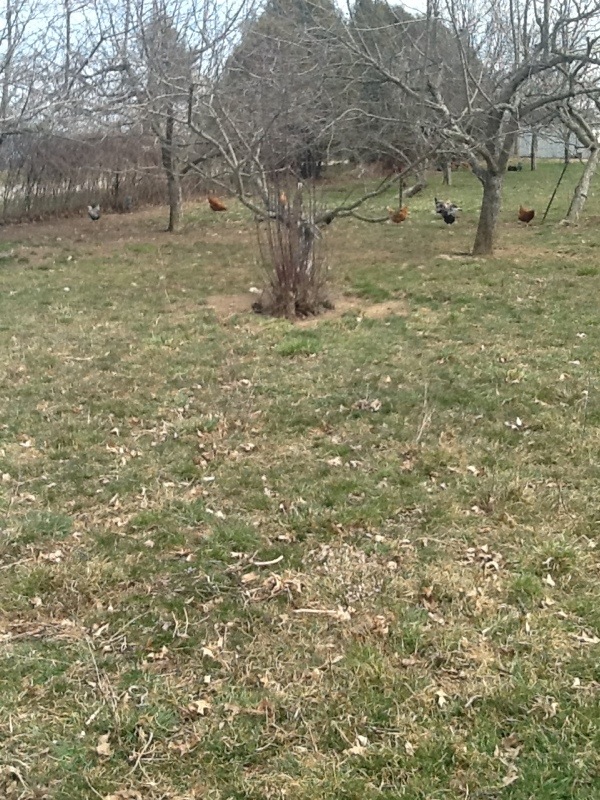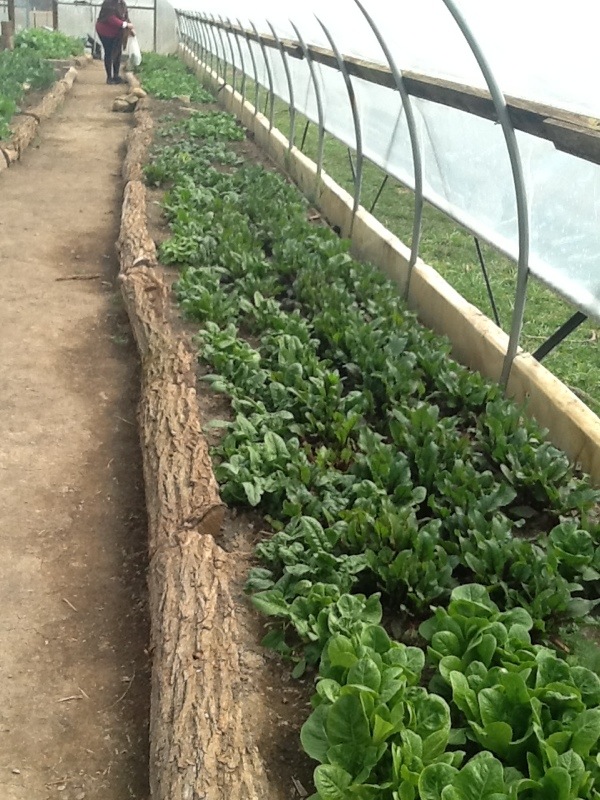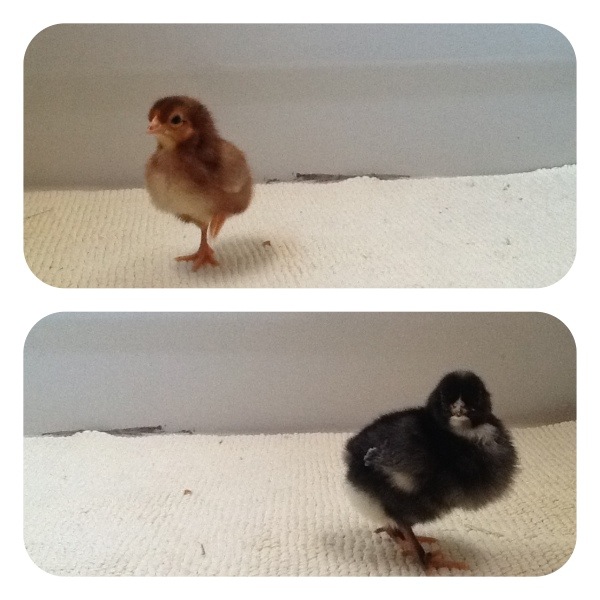This is the third in a four-post series about hatching eggs from our 5 deceased laying hens who fell victim to a predator, along with nearly all of their temporary flock-mates, during their transitional stay at Harmonious Homestead. For more, read The Absence of Chickens and Incubating Chicken Eggs. 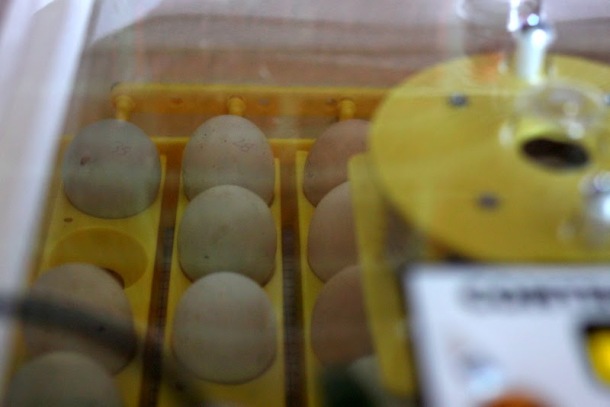 There are varying opinions about the importance, and risk, of candling eggs while hatching them via an incubator. Some feel it is unnecessary exposure to bacteria, which could result in a greater number of developing embryo losses. Others feel it is an essential source of information about how the incubation is progressing and what might be going right or wrong in the incubator. During my first try incubating eggs, I found myself somewhere in the middle, hoping to minimize the risk of contamination while still checking the eggs in order to remove any non-developing eggs and avoid a messy situation. On day 7, I candled each egg for the first time. Previous reading led me to believe that it may be difficult to see the tiny embryos, but i found it to be fairly easy to tell which eggs were developing. Even the blue eggs, with two layers of pigmentation, were fairly easy for me to see through using no special equipment, just the flashlight on my iPhone. I invited Rachel and Lil of Harmonious Homestead over to take a look and assist me with photos. We crowded into the bathroom, our only room without a window. I held my phone in one hand and the egg in the other, sealing the light of the the flashlight as well as I could so that it would shine only through the shell of the egg. The light revealed a spiderweb of veins and a sizable air sac in the developing eggs and just a indistinct cloud of yolk in the duds.
There are varying opinions about the importance, and risk, of candling eggs while hatching them via an incubator. Some feel it is unnecessary exposure to bacteria, which could result in a greater number of developing embryo losses. Others feel it is an essential source of information about how the incubation is progressing and what might be going right or wrong in the incubator. During my first try incubating eggs, I found myself somewhere in the middle, hoping to minimize the risk of contamination while still checking the eggs in order to remove any non-developing eggs and avoid a messy situation. On day 7, I candled each egg for the first time. Previous reading led me to believe that it may be difficult to see the tiny embryos, but i found it to be fairly easy to tell which eggs were developing. Even the blue eggs, with two layers of pigmentation, were fairly easy for me to see through using no special equipment, just the flashlight on my iPhone. I invited Rachel and Lil of Harmonious Homestead over to take a look and assist me with photos. We crowded into the bathroom, our only room without a window. I held my phone in one hand and the egg in the other, sealing the light of the the flashlight as well as I could so that it would shine only through the shell of the egg. The light revealed a spiderweb of veins and a sizable air sac in the developing eggs and just a indistinct cloud of yolk in the duds.  (Viable, developing egg, you can see the embryo as a dark spot just to the left of the corner of the phone.) After candling each egg, I recorded whether or not the egg was developing on a chart. I decided to keep those that did not appear to be developing in the incubator for a few more days before checking them again and discarding them if they were, indeed, lacking embryos.
(Viable, developing egg, you can see the embryo as a dark spot just to the left of the corner of the phone.) After candling each egg, I recorded whether or not the egg was developing on a chart. I decided to keep those that did not appear to be developing in the incubator for a few more days before checking them again and discarding them if they were, indeed, lacking embryos. 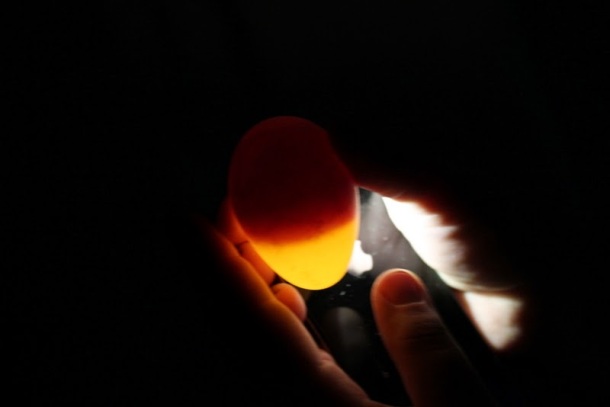 (Another developing egg. Note the spiderweb of veins, slightly difficult to make out in this photo, and the visible air sac at the top of the egg.)
(Another developing egg. Note the spiderweb of veins, slightly difficult to make out in this photo, and the visible air sac at the top of the egg.)  While it was a little disheartening to find that many of the eggs from Rachel’s rooster Shackleton II weren’t developing, we knew the experiment was a long-shot from the beginning. Many of the eggs from her next door neighbor were viable and developing, though. So I knew my clutch would hatch quite a few purebred Ameraucana chicks in just two more weeks.
While it was a little disheartening to find that many of the eggs from Rachel’s rooster Shackleton II weren’t developing, we knew the experiment was a long-shot from the beginning. Many of the eggs from her next door neighbor were viable and developing, though. So I knew my clutch would hatch quite a few purebred Ameraucana chicks in just two more weeks. 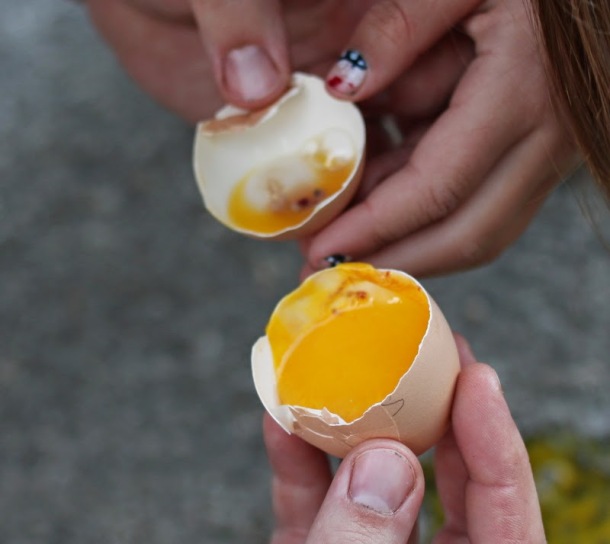 (This egg had a clear blood ring around the yolk. We decided to crack it open and investigate as part of this homesteading/homeschooling activity. The head, body and eye were easy to make out.)
(This egg had a clear blood ring around the yolk. We decided to crack it open and investigate as part of this homesteading/homeschooling activity. The head, body and eye were easy to make out.)
Tag Archives: chickens
Candling Chicken Eggs.
Incubating chicken eggs.
This is the second in a four-post series about hatching eggs from our 5 deceased laying hens who fell victim to a predator, along with nearly all of their temporary flock-mates, during their transitional stay at Harmonious Homestead. For more, read The Absence of Chickens.
Introducing another partner in our quest to raise a new generation of chickens, the HovaBator incubator from City Folk’s Farm Shop.
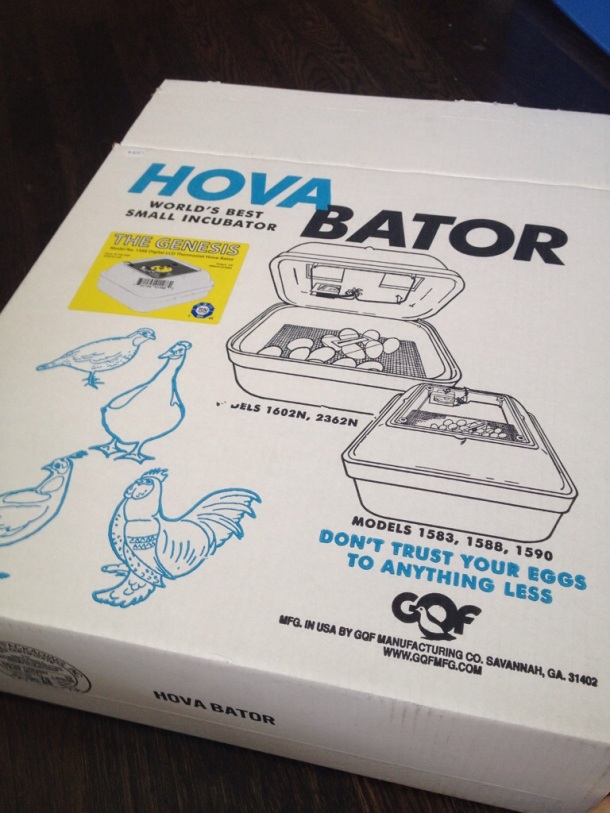
The HovaBator 1588 is a Styrofoam picture-window incubator with digital electronic controls and temperature and humidity sensors. It has a few optional add-ons, including the automatic egg-turner that we brought home with us.
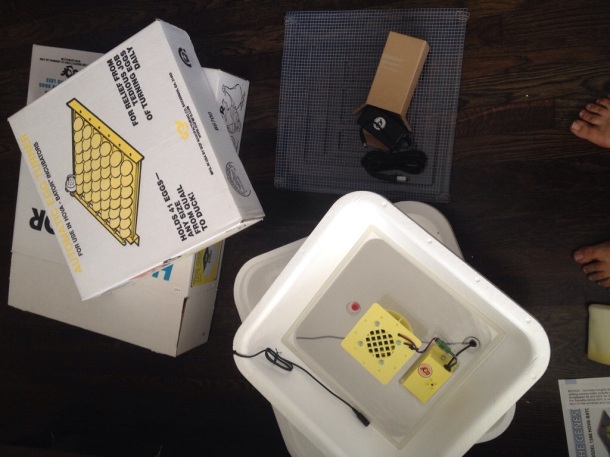
Right out of the box, the entire operation is intuitive and easy to assemble. The bottom tray goes down first, then the water reservoir, the hardware cloth hatching surface and then the lid. Our automatic egg-turner sits on top of the hardware cloth grate, its power cord exiting through a small, specifically-manufactured channel.


The digital controls and sensor reading displays are all on the lid of the incubator, along with the large plexiglass window.
To get the eggs started, I searched the internet and found quite a few informative sites about hatching chicken eggs. Instead of giving you a step-by-step myself, since this is my first time endeavoring to hatch eggs, I’ll point you to some resources in the next post of this series.
Garden update: June 20, 2013
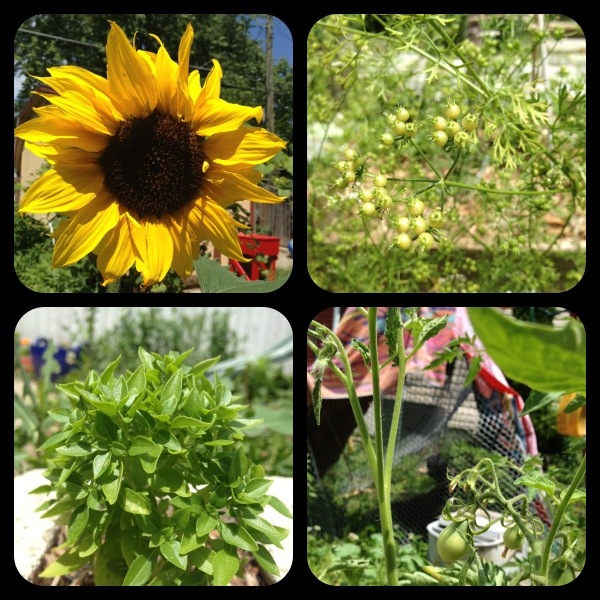
To pick myself up, I’m trying to spend as much time as the heat and sun allow out in our urban yard today. With a cup of Chemex-brewed coffee in hand, I trudged out the back door earlier today with Darren to corral the chickens into our portable chicken pen, a place where they can spend some time foraging for bugs and greens that they don’t have access to in their secure run.
Our garden is coming along nicely this year. The well-spaced rain storms we’ve had in the last two weeks have made for little need to hand water and lush, green growth.
This morning, I harvested the first of our beans for the year. So far they’re thriving, all climbing higher than the supports I’ve made for them. They’re showing no signs of whatever disease took them all out last year, so I remain hopeful.
We have planted over a dozen tomato this year. I was delighted to see, upon returning from Michigan a few days ago, some already setting fruit. Most of the rest are in flower, but we do have some with horribly stunted growth. Tomorrow I’ll stop by City Folk’s for some organic plant food for the stragglers.
Yesterday, I ate the first squash of the season. I thought it was a summer squash, but I neglected to diagram the garden as I squeezed plants in just about everywhere, so I realized while slicing it up that it may have been an immature winter squash. Regardless, it was delicious sautéed in butter with some garlic, onions, cayenne, dill and salt!
On the pest front, I thankfully have little to report. There have been no signs of our urban groundhog; perhaps the trap scared him off? And the squash bugs have not yet shown themselves. I’ve seen lots of bees, ants, ladybugs and praying mantis babies, so we’re at least starting off on the right foot.
That sunflower at the top of this post? A happy surprise that grew in the middle of the beets. I decided to leave it and its three friends growing among the radishes. They’re a lovely addition to my otherwise vegetable-heavy gardens.
As the season progresses, I plan to pop back in with updates. Stay tuned for another foraging report in the next two days!
Stratford Fiber Circle
On Saturday, I drove up to Stratford Ecological Center for the monthly Fiber Circle – an unstructured three hour gathering filled with spinning wheels, pin looms, knitting, felting, coffee, snacks and talk of all things fiber. This month saw attendees ranging from one who was working on her second ever fiber project to a spinner who has been handcrafting yarn for 50 years.
This month, I worked on some free form, experimental felting.
When the meeting wrapped up, I headed outside to see all of the goings-on. I scurried straight to the sheep pen to see the Tunis and Shetland lambs.
A quick aside: When I was in middle school, we had a small flock of sheep on our ten acres of land in the country. Our first spring, we brought home two Merino babies, Spring and April. We added two young adult Columbia sheep to the flock, a ewe and a wether named Kelly and Corey. The next spring, Kelly gave birth to Bounder and a still born twin during the night. The birth was traumatic, but thankfully my dad was able to save Kelly. We added a 4H cast-off sheep named Little Guy, an Angora goat we called DeeDee and Buddy the Pygmy goat to round out our flock.
After watching the sheep, I moved on to admire the orchard/ chicken run. I’ve learned that housing hens under trees prevents hawk attacks. The hawks like to have a clear entry and exit route, and the trees obscure that. If we end up with an acre or two in a few years, this is a set-up I would like to replicate, on a smaller scale.
Finally, I took a look around Stratford’s revamped hoop house. They are growing some really lovely greens, for sale by weight. I didn’t buy any this time, but the process is easy – grab a pair of scissors and a bag, hanging by the door, and self-harvest what you’d like. Weigh and pay for your selections in the visitor center/shop.
As usual, I enjoyed getting out of the city and into the openness of the country. If you are interested in fiber arts, considering doing the same. The Stratford Fiber Circle meets the first Saturday of the month, from 10:00 until 1:00, and the fee is only $10 for the entire year. If you come, I’ll even set you up to wet felt if you’d like! See you there?
Raising chicks! Another step in urban homesteading.
We’ve been busily preparing for the arrival of three new additions (plus two next door), and we finally got to meet them today.
Here they are.
Austra and Batgirl.
And these three, yet to be named. (The top photos are two different shots of the same two chicks.)
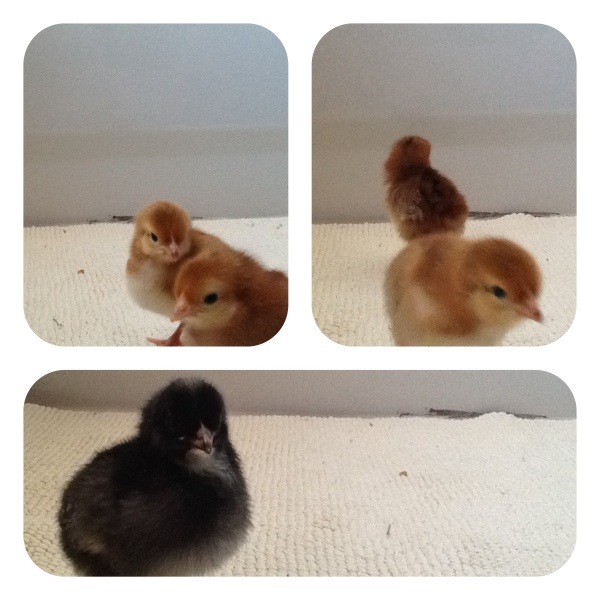
Austra and her match are two Barred Plymouth Rock chicks. The other three are Rhode Island Reds. If the hatchery is correct, they will all be backyard layers, no Roos, in a coop that is shared between our house and the house next door. We feel extremely grateful that the owners of both houses moved to Franklinton with urban homesteading in mind and have encouraged us, their tenants, to follow the same path if our hearts’ desire. Especially grateful because, yes, we absolutely desire just that.
Darren is excited about the chicks. He and I have checked on them and given them attention at least once an hour today. All five chicks are spirited and inquisitive. At just 18 hours olds, they have already begun to respond to my rough attempt at clucking, demonstrated to me by Denise Beno Anderson who was on hand to give pointers when we picked the chicks up from City Folk’s Farm Shop today.
If you’re thinking about chicks, check out the wealth of collective knowledge at Backyardchickens.com. And if you’re in the Columbus area, consider ordering your chicks through City Folk’s here. They have four more batches of chicks coming, all different breeds, including the heritage Buckeye, developed by a woman in Ohio.
Here’s to backyard eggs!
(Check out City Folk this week for their one-year anniversary festivities running until Saturday, March 23.)
